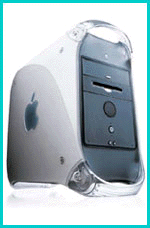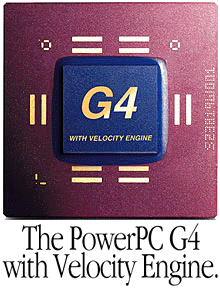 Ray's New Super Computer. Delivered April
20, 2000.
Ray's New Super Computer. Delivered April
20, 2000.
WHAT'S INSIDE A G4?
Using six of Intel's tests, the 500MHz G4 (with its 128-bit Velocity Engine) is over twice as fast as the 800MHz Pentium III.
These benchmark advantages translate directly into real-world advantages.
More and more software developers have tapped the power of the G4 with its Velocity Engine to accelerate the performance of their applications &emdash; just as Adobe has done with Photoshop. Because gigaflops really do matter when your work revolves around graphics, animation, 3D games, video effects, 3D rendering and a host of other computation-hungry software.
Chances are, you've never even heard of a gigaflop before. But very soon you won't be able to live without at least one on your desk.

ARTICLE April 12, 2000, 11:22PM
Power Mac G4 desktop best because of
its blinding speed
By BOB LeVITUS
JUST A MONTH AGO I declared my G3 FireWire PowerBook "the best
PowerBook I've ever owned." And now, after a month of testing, I'm
going to declare the Power Mac G4 the best desktop Mac I've ever
used.
For the record, the system I tested had a 450-megahertz G4
processor, 1-megabyte L2 cache, 128-MB SDRAM memory, a 20-gigabyte
Ultra ATA hard disk, Zip drive, DVD-ROM/DVD Video, Rage 128 Pro,
and 10/100 Base-T ethernet. Like all modern desktop Macs, it
included USB and FireWire ports and was "AirPort-ready."
All I can say is that this system was blindingly fast. Microsoft
Word launched in about half the time it takes on my G3/300.
Photoshop filters take a fraction of the time they take on my
G3/300. And Final Cut Pro rendered video sequences twice as fast as
my G3/300.
All this from a system that costs just $2,499 -- about what I paid
for the G3/300 18 months ago. (There is an even lower-priced G4
available -- a G4/400 with 64MB of RAM and a 10-GB UltraATA/66 hard
drive can be had for as little as $1,599.)
What makes the Power Mac G4 so fast? Mostly it's the PowerPC G4
chip with Velocity Engine, which brings supercomputer capabilities
to the desktop for the first time. According to Apple, the 500 MHz
PowerPC G4 with Velocity Engine is 2.2 times faster than an 800-MHz
Pentium III when running Intel's own signal processing tests.
Other reasons this machine is so fast include its 100-MHz system
bus, a superfast UltraATA/66 hard drive, 64-bit PCI slots, and
"data stream prefetching" (the G3 can execute four simultaneous
32-bit data stream prefetches; the Pentium III executes only a
single 32-bit block prefetch). All of this combines to make this G4
the fastest Mac I've ever laid my hands upon.
Several programs -- including Photoshop and Final Cut Pro -- have
been enhanced to take advantage of the Power Mac G4's Velocity
Engine. And, according to Apple, more than 60 developers are
planning Velocity Engine support, with more than 20 of them already
shipping. But the most amazing part was that even my older software
ran flawlessly and speedily on the G4.
There's all sorts of other stuff to love about the new G4s, from
the fact that you can have up to 1.5 GB of RAM (if you can afford
it) to the fact that you can have more than 100 GB of internal hard
disk storage. Perhaps the most interesting, though, is the optional
DVD-RAM drive that reads CD-ROMs and DVD ROM discs and can write
and rewrite data to DVD-RAM discs that can hold up to 5.2 GB of
data.
These discs can be written, erased and rewritten thousands of
times, with a cost per megabyte of storage that is much cheaper
than Zip discs or, in fact, most other forms of media.
My favorite factoid, though, is that the Power Mac G4 was the first
personal computer to cross the threshold of 1 billion
floating-point operations per second (also known as a gigaflop). By
doing so, it entered the rarefied realm of supercomputing and got
the attention of the U.S. government. The Pentagon regards
supercomputers as "strategic technology," in effect making the
Power Mac G4 a weapon that shouldn't fall into the wrong hands.
But if you're smart, you'll let one fall into yours.